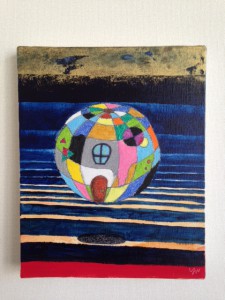ELSI Blog
20 Art and Science

Art is very different from science in the final products that it delivers. A piece of art cannot be measured or verified or objectively compared to other pieces of art, the way scientific results can. Yet art is remarkably similar to science in its initial stages of inspiration, when new ideas are bubbling up.
Science is typically seen as a very rational intellectual enterprise. Apart from perhaps an initial stroke of genius, scientific research has this image of painstakingly following lines of reasoning. However, such a picture couldn't be further from the truth. Really original research in science is full of emotional hurdles, from anticipation to desperation, from excitement to frustration, very much like the writing of a great novel or the creation of an new style in painting.
The fact that the end result of science has such objective traits should not blind us in judging its true nature. The fact that the winners of a marathon race are determined by using a stopwatch does not mean that sports is all about time keeping. On the contrary, the time keeping is like an afterthought, only a technique to determine the winners. In a similar way, rational objective judgments are only a technique used as an afterthought, in attempts to determine scientific winners. And as history has taught, it sometimes takes a long time to know who the real winners are, when unpopular theories can languish for decades until new arguments are found to show their so far unrecognized value.
This widespread misunderstanding of the nature of science has produced at least two huge casualties. One is the way science is regulated, through grants and promotions. Current attempts to measure scientific output, through counts of articles, reference citations, h factors, and various other statistical tricks, are threatening to weed out the truly creative maverick scientists who have the potential to make real breakthroughs. Another casualty is the way science is made uninteresting for high school kids, who wrongly perceive science to be dull and nerdy, largely devoid of emotional and creative aspects, because the true excitement of scientific discovery is hard to replicate in the class room.
How to show the true colors of scientific research, with its mix of emotions and reasoning, creativity and objectivity? One major problem is that many scientists themselves have come to believe in the myth of science being so very different from art, and so much more rational. How to show the limitations of such a view?
One way is to cross boundaries. No matter how much we can pretend that science is a purely rational enterprise, as soon as scientists move from one country to another, they realize how many non-rational factors are different in the way life is lived and science is done in the other country. Similarly, whenever scientists move from one academic field to another, or start seriously collaborating with others in different fields, they are faced with very different standards which at first seem rather irrational, compared to what they were used to in their own fields.
ELSI forms a perfect laboratory to explore this kind of boundary crossing, in its dual emphasis on international and on interdisciplinary research. It is therefore important to keep our eyes open for those two central aspects of the nature of ELSI as a WPI institute. Through the lens of ELSI we may have a chance to see how art lies at the heart of science.
Let me close these musings with a picture of a painting by Yu Kaneta, whom I met several years ago in Kyoto where she was studying art, when we had some interesting conversations about art, science, and society. She has moved on to try to let art play a greater role in society, and specifically in medical environments. For that purpose she is now attending a nursing school in Tokyo. The painting depicted here, hanging behind my desk at ELSI, she painted for me for my birthday, almost a year ago.
At that time ELSI was still only a glimmer in the eyes of the PIs who had written the WPI proposal, and neither Yu nor I knew that I would soon be asked to move into new research directions related to the origins of life. It was a wonderful coincidence that she decided to create a painting of the Earth, floating in the Universe, the way she did, covering the world with abstract symbols, a door and a window. I like to think of the young Earth as providing a door to the origin of life; by producing humans, capable of abstract thinking, life provided a window on the world at large, when human consciousness developed both art and science.
For those interested in artist Yu Kaneta's work on the role of art on health and healing, please check out her site http://artandhealthandhealing.blogspot.jp/











